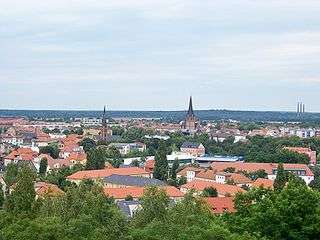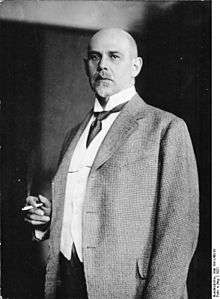Bitterfeld
Bitterfeld (German pronunciation: [ˈbɪtɐfɛlt]) is a town in the district Anhalt-Bitterfeld, Saxony-Anhalt, Germany. Since 1 July 2007 it has been part of the town Bitterfeld-Wolfen. It is situated approximately 25 km south of Dessau, and 30 km northeast of Halle (Saale). At the end of 2016, it had 40,964 inhabitants.[1]

History and description

Bitterfeld was built by a colony of Flemish immigrants in 1153. It was captured by the landgrave of Meissen in 1476, and belonged thenceforth to Saxony, until it was ceded to Prussia in 1815.[2]
By 1900, Bitterfeld station was an important junction of the Berlin–Halle and the Magdeburg–Leipzig railways. The population at that time was 11,839; it manufactured drain-pipes, paper-roofing, and machinery, and had saw mills. There were also several coal mines in the vicinity. Owing to its pleasant situation and accessibility, it had become a favoured residence of business men of Leipzig and Halle.[2]
During the East Germany (GDR) years, it gained notoriety for its chemical industry complex which caused remarkably severe pollution, even by GDR standards. On 24 April 1959 it also was a scene for the Bitterfeld Conference, locally known as the "Bitterfelder Weg". This conference sought to connect the working class with the artists of the day to form a socialist national culture.[3]
In the 21st century Bitterfeld is still an industrial town and it stages the annual United Metal Maniacs metal festival.[4]
The former brown-coal open cast mine of Goitzsche, south-east of Bitterfeld, is a source of numerous fossils in Bitterfeld amber.
Historical population
| Year | Population |
|---|---|
| 1840 | 4,649 |
| 1870 | 5,693 |
| 1880 | 6,531 |
| 1890 | 9,047 |
| 1925 | 18,384 |
| 1933 | 21,328 |
| 1939 | 23,949 |
| Year | Population |
|---|---|
| 1946 | 32,833[EW 1] |
| 1950 | 32,814[EW 2] |
| 1960 | 31,687 |
| 1981 | 22,199 |
| 1984 | 21,279 |
| 1990 | 18,099[EW 3] |
| 1995 | 16,868 |
| Year | Population |
|---|---|
| 2000 | 16,507 |
| 2001 | 16,237 |
| 2002 | 15,985 |
| 2003 | 15.798 |
| 2004 | 15,755 |
| 2005 | 15,728 |
| 2006 | 15,709[EW 4] |
(from 1840 to 2006):[5]

Sons and daughters of the town
- Johann Ernst Altenburg (1736-1801), trumpeter and organist
- Erwin Ding-Schuler (1912-1945), sturmbannführer and first camp doctor of Buchenwald
- Peter Rasym (born 1953), musician, has been playing bass guitar since 1997 with the Puhdys
Other personalities

- August von Parseval (1861-1942), his impact airships developed by him were partly built in Bitterfeld.
- Walther Rathenau (1867-1922), founder of Bitterfeld's chemical industry.
- Klaus Staeck (born 1938), graphic artist, lawyer and president of the academy of the arts, grew up in Bitterfeld.
Mayors
- 1851-1863 Gottlieb Meuche
- 1863-1873 Gustav Frischbier
- 1873-1890 Robert Sommer († 1890)
- 1890-1914 Hugo Hermann Adalbert Dippe (1853; † 1916)
- 1915-1927 Ernst Albert Hermann Schmidt
- 1927-1939 Arthur Erdmann Ebermann
- 1939-1945 Erhard Johann Martin Nimz
- 1943-1945 Walter Stieb (Interim)
- 26 April 1945 to 30 August 1945 Gustav Dietrich (deselection by Soviet city commandant) († 1972)
- September 1945 to 1946 Bernhard Moder
- 1946-1949 Ernst Rettel
- 1949-1950 Karl Salbach
- 1950-1953 Heinz-Rudolf Strauch
- 1953-1959 Wolfgang Stille
- 1959-1971 Else Petrushka
- 1971-1979 Max Dittbrenner
- 1979-1982 Karlheinz Sohr
- 1982-1990 Klaus Barth
- 1990-1994 Edelgard Kauf
- 1994-2007 Werner Rauball
- 2007-2009 Horst Tischer
- From 2010 Joachim Gülland
Literature
- Maron, Monika: Bitterfelder Bogen. Ein Bericht. Fischer Verlag, Frankfurt am Main 2009, ISBN 978-3-10-048828-2.
- Lojewsky, Hannelore: Seh’n wir uns nicht in dieser Welt, so seh’n wir uns in Bitterfeld. In: Norbert Kühne: Individuelles Lernen wird an Bedeutung gewinnen. 100 Jahre Hans-Böckler-Berufskolleg Marl/Haltern, Marl 2009, S. 29–30.
- Klaus Seehafer: Dann sehn wir uns in Bitterfeld. Tagebuch eines Jahres. Mitteldeutscher Verlag, Halle/S. 2009, ISBN 3-89812-664-1.
- Bitterfeld und das untere Muldetal. Edition no. 1 Böhlau, Cologne; Weimar; Vienna 2004, ISBN 3-412-03803-2 (Werte der deutschen Heimat. Vol. 66).
- Hackenholz, Dirk: Die elektrochemischen Werke in Bitterfeld 1914–1945. Ein Standort der IG-Farbenindustrie AG. LIT Verlag, Münster 2004, ISBN 3-8258-7656-X.
Notes
- 29 October
- 31 August
- 3 October
- 30 June
References
- Statistical information
-

- "Bitterfelder Konferenzen", Kulturpolitisches Wörterbuch (2nd print ed.), Berlin: Dietz Verlag, 1978
- Festung Bitterfeld - 15 Jahre (1997-2012) (in German), retrieved 2013-01-18
- Data source since 1995: Statistisches Landesamt Sachsen-Anhalt
External links
| Wikimedia Commons has media related to Bitterfeld. |
- Stadt Bitterfeld-Wolfen, Stadt Bitterfeld-Wolfen - Wir haben den Bogen raus (in German), 51.656105;12.267308: Bitterfeld.de, retrieved 2013-01-18CS1 maint: location (link)
- Prochaska Online Service, Willkommen bei bitterfeld-online » Bitterfeld-Online (in German), 51.63;12.33: Bitterfeld-online.de, archived from the original on 2012-02-04, retrieved 2013-01-18CS1 maint: location (link)
- Der Pegelturm an der Goitzsche bei Bitterfeld (in German), Pegelturm.de, retrieved 2013-01-18
- Bandcommunity-bitterfeld.de (in German), Bandcommunity-bitterfeld.de, archived from the original on 2012-02-05, retrieved 2013-01-18
- Der Bitterfelder Bogen
- Bitterfeld at Curlie
